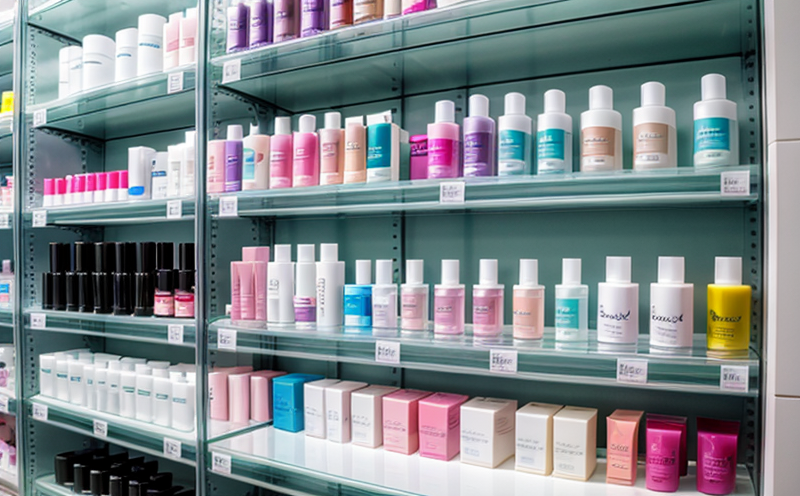Packaging Compatibility Testing for Cosmetic Shelf Life
When developing a cosmetic product, ensuring its shelf life is critical to maintaining consumer trust and regulatory compliance. Packaging compatibility testing specifically addresses the interaction between a cosmetic formulation and its packaging materials over time. This ensures that the container not only protects the product but also does not cause degradation or affect the sensory properties of the cosmetic.
The primary goal of this testing is to identify any potential incompatibilities that could lead to quality issues, such as discoloration, loss of efficacy, or altered texture. By understanding these interactions, manufacturers can make informed decisions about material selection and packaging design, thereby enhancing product stability and ensuring consumer satisfaction.
Several key factors influence the compatibility between a cosmetic formulation and its packaging:
- PH Sensitivity: Many cosmetics are sensitive to changes in pH. Testing ensures that the packaging does not alter the formulation's pH over time.
- Oxygen Penetration: Oxygen can cause oxidative degradation, affecting the stability and efficacy of certain cosmetic ingredients like vitamins or antioxidants.
- Moisture Absorption: Some formulations require airtight containers to prevent moisture ingress which can lead to mold growth or product spoilage.
- Chemical Reactions: Certain packaging materials may react chemically with the cosmetic contents, leading to off-flavors, odors, or changes in color.
The testing process involves a series of accelerated stability tests designed to mimic real-world storage conditions. These tests are conducted under controlled environmental conditions that accelerate the aging process. This allows researchers and quality managers to predict long-term effects on cosmetic product integrity more quickly than would be possible with natural aging.
| Test Conditions | Description | Purpose |
|---|---|---|
| Temperature (40°C) | High temperature to accelerate chemical reactions and physical changes. | To simulate extreme heat conditions during shipping or storage in hot climates. |
| Humidity (75% RH) | High humidity to assess moisture absorption and potential mold growth. | To replicate storage conditions that may lead to product spoilage. |
| Air Exposure (20°C, 65% RH) | Standard atmospheric conditions for long-term stability testing. | To evaluate the overall impact of typical environmental factors on cosmetic products. |
| Oxygen Scavenging Containers | Testing with and without scavengers to assess packaging's oxygen permeability. | To determine if packaging can effectively prevent oxidation. |
The data collected from these tests is analyzed by comparing the initial properties of the formulation with those observed after exposure. This comparison helps identify any degradation or changes in the product that could impact its quality and safety over time. Packaging compatibility testing thus plays a crucial role in ensuring product integrity, extending shelf life, and meeting regulatory requirements.
Applied Standards
The International Organization for Standardization (ISO) provides several standards relevant to packaging compatibility testing:
- ISO 10993-18:2006: This standard covers the biocompatibility testing of medical devices, which includes considerations for materials that come into contact with the skin or mucous membranes. Although not exclusively focused on cosmetics, it provides a framework for evaluating potential allergenic and toxic effects.
- ISO 14971:2007: This standard outlines the application of risk management to medical devices, which can be adapted for cosmetic packaging evaluation by considering potential risks associated with material interactions.
In addition to ISO standards, other international bodies such as ASTM and EN provide specific guidance on packaging testing:
- ASTM F2318-05(2017): This standard specifies procedures for determining the oxygen transmission rate (OTR) of materials used in packaging, which is crucial for assessing the potential for oxidative degradation.
- EN 12968:2004: This European standard provides methods for evaluating the resistance to chemical migration from packaging into food or beverages. While primarily focused on food and beverage packaging, it offers valuable insights into preventing contamination in cosmetic containers.
The International Electrotechnical Commission (IEC) also contributes through standards like IEC 62784-1:2019, which specifies requirements for the safety of medical electrical equipment, some of which can be applied to ensure that packaging materials do not introduce hazardous substances into cosmetic products.
Scope and Methodology
The scope of packaging compatibility testing covers a wide range of interactions between the cosmetic formulation and its packaging. This includes evaluating physical, chemical, and biological changes that can occur over time. The methodology involves several key steps:
- Specimen Preparation: Samples of both the cosmetic formulation and the packaging materials are prepared according to industry standards.
- Accelerated Stability Testing: The samples are subjected to accelerated environmental conditions, such as high temperature and humidity, to simulate long-term exposure.
- Analysis: Various analytical techniques are employed to assess changes in properties like pH, color, viscosity, and microbial count. These tests help determine if the packaging is contributing positively or negatively to the cosmetic's shelf life.
- Evaluation and Reporting: The data collected from these analyses is used to evaluate the compatibility of the packaging with the cosmetic formulation. A detailed report summarizing findings and recommendations for potential improvements in packaging design is provided.
The results of this testing are essential for ensuring that the packaging not only protects the product but also enhances its shelf life. By identifying any issues early in the development process, manufacturers can make necessary adjustments to improve product quality and meet regulatory standards.





